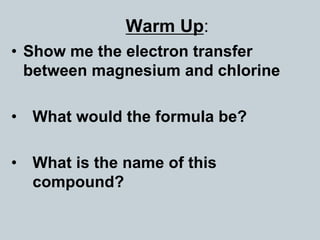
Ch. 7.3 Covalent Bonding
- 1. Warm Up: • Show me the electron transfer between magnesium and chlorine • What would the formula be? • What is the name of this compound?
- 2. Covalent Bonding • Covalent Bond: Valence electrons shared between two atoms. • Molecule – a group of covalently bonded atoms. – Molecules usually consist of a nonmetal bonded to a nonmetal or a metalloid bonded to nonmetal.
- 3. • Example: H2 • s-orbital of one hydrogen atom overlaps with the s- orbital of an other hydrogen atom. • A dash is used to represent a shared pair of electrons. • Example: Cl2 • Single covalent bond – share one pair of electrons between two atoms.
- 4. Drawing Molecules • We can use electron dot notation to help show how the atoms in a molecule are held together. • These drawings are known as Lewis structures. • All atoms seek to fill their outer energy shell, most follow the Octet rule, where they will have 8 electrons on their outer level. – Hydrogen only wants 2, as it’s in the 1s energy level.
- 5. Multiple Covalent Bonds • Sometimes it is possible to form more than one covalent bond between two atoms. • Example: O2 • Double covalent bond – share two pairs of electrons between the same two atoms.
- 6. • Example: N2 • Triple covalent bond – share three pairs of electrons between the same two atoms. • Double and triple covalent bonds are referred to as multiple covalent bonds.
- 7. LEWIS STRUCTURES WITH MULTIPLE COVALENT BONDS • Example: CH2O • If all electrons have been used and the central atom is not stable, then consider a multiple bond. • Convert two dots to a dash. • Example: CO2
- 8. Polyatomic Ions • Group of covalently bonded atoms that has a charge. (a charged molecule) • Example: SO4 -2 (sulfate ion) • These bond ionically with cations
- 9. Multiple Covalent Bonds • Sometimes it is possible to form more than one covalent bond between two atoms. • Example: O2 • Double covalent bond – share two pairs of electrons between the same two atoms.
- 10. • Example: N2 • Triple covalent bond – share three pairs of electrons between the same two atoms. • Double and triple covalent bonds are referred to as multiple covalent bonds.
- 11. LEWIS STRUCTURES WITH MULTIPLE COVALENT BONDS • Example: CH2O • If all electrons have been used and the central atom is not stable, then consider a multiple bond. • Convert two dots to a dash. • Example: CO2
- 12. Naming Binary Molecular Compounds • Unlike ionic compounds, molecular compounds are composed of individual covalently bonded units, or molecules. • The old system (prefix system) of naming molecular compounds is based on the use of prefixes. – examples: CCl4 — carbon tetrachloride (tetra- = 4) CO — carbon monoxide (mon- = 1) CO2 — carbon dioxide (di- = 2)
- 13. Prefixes for Naming Covalent Compounds
- 14. Independent Practice a. Give the name for As2O5. b. Write the formula for oxygen difluoride.
- 15. Polar and Nonpolar Covalent Bonds • Covalent bonding involves sharing electrons between atoms. • Nonpolar covalent bond – equal sharing of electrons between two atoms. – Both atoms have same attraction for shared pair. – Example: H – H
- 16. • Polar covalent bond – unequal sharing of electrons between atoms. – One atom has greater attraction for shared pair. (Electronegativity Tug – of – War) – Example: H – Cl • This creates partial (d) charges on each atom in the bond.
- 17. • The atom that has a greater attraction for shared electrons takes on a partial negative charge. The atom with a weaker attraction takes on a partial positive charge. – How can you determine which atom has greater attraction for electrons? – ELECTRONEGATIVITY